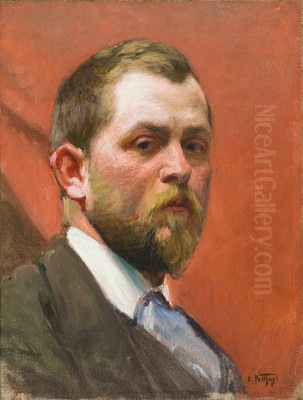
Edward Henry Potthast stands as a significant figure in the annals of American art, celebrated primarily for his luminous and joyful depictions of leisure activities at the turn of the 20th century. An American Impressionist painter, his canvases shimmer with the bright sunlight of coastal beaches and the relaxed atmosphere of urban parks, capturing moments of carefree enjoyment. Born in Cincinnati, Ohio, in 1857, Potthast's artistic journey took him from the Midwest to the art capitals of Europe and finally to New York City, where he solidified his reputation. His work, characterized by vibrant color palettes and energetic brushwork, continues to resonate with audiences, offering a glimpse into the optimistic spirit of American life during his time.
Early Life and Artistic Beginnings in Cincinnati
Edward Henry Potthast entered the world on June 10, 1857, in Cincinnati, Ohio. His parents were German immigrants; his father, Henry Ignatz Potthast, worked variously as a carpenter and potentially a stonemason, while his mother, Bernadine Scheffiles (or possibly Scheiffers), contributed to the household, sometimes cited as a teacher. Growing up in a modest household, young Edward displayed an early inclination towards art. His father, grounded in the practicalities of a craftsman's life, reportedly offered initial guidance in basic drawing techniques but harbored reservations about art as a viable profession, perhaps attempting to steer his son towards a more secure trade.
Financial constraints were a reality for the Potthast family, impacting Edward's formal education. He was compelled to leave school at the young age of sixteen to contribute to the family income. He found employment at a local printing establishment, the Strobridge Lithography Company, where he learned the demanding craft of lithography. This early immersion in the world of printing and graphic arts, while born of necessity, undoubtedly honed his technical skills, discipline, and understanding of composition and tone, providing an unexpected but solid foundation for his later artistic pursuits.
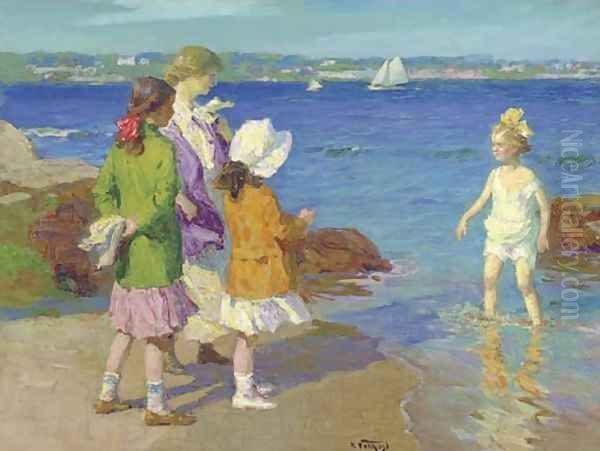
Despite the demands of his work, Potthast's artistic aspirations remained undimmed. He dedicated his evenings to furthering his art education. From approximately 1870, and more formally between 1879 and 1881, he enrolled in classes at the McMicken School of Design, later known as the Art Academy of Cincinnati. This institution provided him with crucial foundational training, allowing him to develop his drawing and painting abilities under the guidance of instructors familiar with prevailing academic traditions. His time at McMicken marked the formal beginning of his lifelong dedication to art.
European Studies and Broadening Horizons
The ambition to deepen his artistic knowledge led Potthast to Europe, a common path for aspiring American artists of his generation seeking advanced training and exposure to the masterpieces of the past and the innovations of the present. His first significant European sojourn began around 1881 or 1882. He initially traveled to Antwerp, Belgium, where he enrolled at the Royal Academy of Fine Arts, immersing himself in the rigorous academic training prevalent there. This experience provided him with a strong grounding in traditional techniques.
Following his time in Antwerp, Potthast moved to Munich, Germany, a major art center rivaling Paris at the time. He continued his studies at the prestigious Royal Academy in Munich. Here, he notably studied under the American expatriate painter Carl Marr, absorbing the tenets of the Munich School, known for its dark palettes, bravura brushwork, and emphasis on realism, particularly in portraiture and genre scenes. The influence of this style can be discerned in some of Potthast's earlier works, characterized by their tonal contrasts and solid forms.
Paris, the undisputed heart of the late 19th-century art world, was an essential destination. Potthast spent time studying and working in the French capital, absorbing the revolutionary changes occurring in art. He is known to have studied with figures such as Fernand Cormon, a respected academic painter whose atelier attracted many international students, and possibly Jules-Joseph Lefebvre, another prominent academician. Perhaps more significantly, his time in France exposed him directly to the burgeoning Impressionist movement and the Barbizon School's emphasis on landscape painting and capturing natural light. Artists like Roderic O'Conor, an Irish painter associated with the Pont-Aven school, may also have been part of his circle or influence during this period.
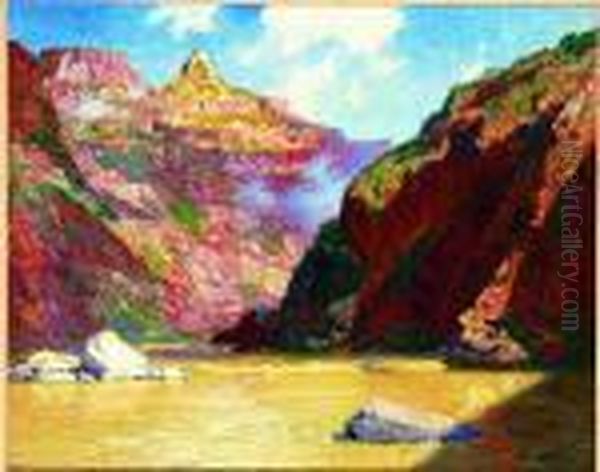
These years abroad were transformative. Potthast synthesized the various influences – the academic rigor of Antwerp, the tonal realism of Munich, the Barbizon focus on landscape, and the revolutionary light and color of French Impressionism. He honed his skills, broadened his artistic vocabulary, and began experimenting with painting en plein air (outdoors), a practice central to Impressionism. He returned to Cincinnati periodically but made a more extended return trip to Europe, particularly Paris, around 1887, further solidifying the impact of French art on his developing style before eventually settling in New York.
Establishing a Career in New York
In 1895, seeking greater opportunities and a more vibrant artistic milieu, Edward Potthast made the pivotal decision to relocate to New York City. This move marked a significant turning point in his career, shifting his focus increasingly away from lithography and towards full-time painting and illustration. New York, rapidly becoming the cultural and artistic hub of the United States, offered a larger market, more exhibition venues, and a community of fellow artists exploring modern styles.
Upon arriving in New York, Potthast initially supported himself, at least in part, through illustration work. He secured commissions from prominent magazines of the era, including Harper's Magazine and Scribner's Magazine. Creating illustrations for these widely circulated publications provided him with financial stability and kept his work visible to a broad audience. This experience likely further refined his compositional skills and narrative abilities, demanding clarity and visual appeal.
However, Potthast's primary passion remained painting. He established a studio in the city and began actively participating in the New York art scene. He submitted his paintings to various exhibitions, gradually building his reputation. His subject matter began to shift towards the themes that would define his mature work: the bustling life of the city, particularly its parks, and the burgeoning leisure culture manifesting on the nearby beaches of New York and New England. The energy and light of the city and its surroundings proved immensely inspiring.
The Embrace of Impressionism
While Potthast's European training exposed him to Impressionism, it was during his years in New York, likely from the mid-1890s onwards, that its influence fully blossomed in his work. American Impressionism was gaining traction, championed by artists like Childe Hassam, J. Alden Weir, and John Henry Twachtman, some of whom Potthast would come to know. He embraced the core tenets of the style, adapting them to his own sensibilities and American subjects.
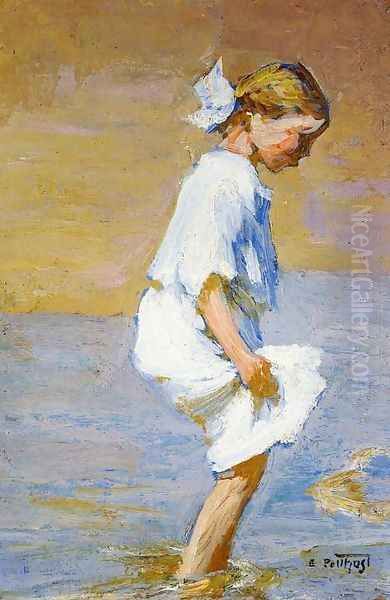
The most noticeable change was in his palette. The darker, tonal qualities associated with the Munich School gave way to a much brighter range of colors. Potthast became adept at capturing the dazzling effects of sunlight on water, sand, and foliage. He employed high-key colors, often applied with pure, unmixed hues side-by-side, allowing the viewer's eye to blend them optically, creating a vibrant, shimmering effect characteristic of Impressionism.
His brushwork also transformed, becoming looser, quicker, and more visible. Instead of smoothly blended surfaces, Potthast used broken brushstrokes – dabs, dashes, and flicks of paint – to convey the fleeting impressions of light and movement. This technique allowed him to capture the immediacy of a moment, whether it was the sparkle of waves, the dappled sunlight under trees, or the energetic movements of children at play. His application of paint often became thicker, adding texture and physicality to the canvas surface.
Potthast masterfully applied these Impressionist techniques to his chosen subjects. He wasn't merely imitating French Impressionism; he was using its language to depict distinctly American scenes and experiences. His focus remained on capturing the positive, joyful aspects of life, rendered with an infectious optimism and a keen eye for the interplay of light, color, and atmosphere. This successful adaptation cemented his place among the leading American Impressionists of his generation.
Signature Subjects: Sunlit Beaches and Urban Oases
Edward Potthast is perhaps best remembered for his vibrant depictions of beach scenes. Fascinated by the burgeoning culture of seaside leisure, he frequented the beaches of New York (like Coney Island and Long Beach) and the coastlines of New England (including popular artist colonies in Rockport, Gloucester, and Ogunquit, Maine). These locations provided the perfect setting for exploring the effects of brilliant sunlight on sand, water, and figures.
His beach canvases typically teem with life and color. He often focused on families and, particularly, children, capturing their uninhibited joy as they wade in the surf, build sandcastles, or relax under colorful umbrellas. The figures are often simplified, rendered with dynamic strokes that emphasize movement and gesture rather than precise detail. The compositions skillfully balance the expanse of sea and sky with the activity along the shore, using the strong horizontal lines of the horizon and shoreline as anchors. The dominant impression is one of warmth, light, and carefree summer days.
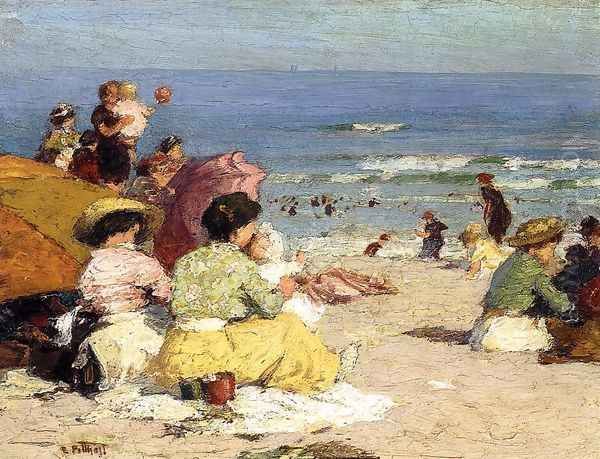
Alongside his coastal scenes, Potthast frequently turned his attention to the urban landscape, specifically the parks of New York City, most notably Central Park. These paintings offer a different kind of leisure scene, capturing city dwellers enjoying moments of respite amidst nature within the metropolis. He depicted people strolling along pathways, relaxing on benches under dappled sunlight filtering through trees, or children playing near ponds. These park scenes share the bright palette and lively brushwork of his beach paintings, celebrating the simple pleasures and the civilizing presence of green spaces within the urban environment.
Potthast's dedication to these themes reflects not only his artistic interests but also the social context of his time. The late 19th and early 20th centuries saw the rise of a middle class with more leisure time and the increasing popularity of public parks and seaside resorts as accessible destinations for recreation. His paintings serve as a cheerful chronicle of this aspect of American life, rendered through the luminous lens of Impressionism. It's noted he might have favored different media depending on the season or setting, possibly using watercolor or gouache for quick summer sketches en plein air due to their portability and fast drying times, while reserving oils for more finished studio works or perhaps winter scenes.
Exploring the American West: The Grand Canyon
While renowned for his East Coast scenes, Potthast's artistic explorations also took him westward. Around 1910 and possibly on subsequent trips, he traveled to the American Southwest, notably visiting the Grand Canyon in Arizona. This venture was reportedly facilitated or commissioned by the Atchison, Topeka and Santa Fe Railway, which often sponsored artists to create works depicting the scenic wonders along its routes, thereby promoting tourism.
The Grand Canyon presented a vastly different challenge compared to the familiar beaches and parks. The immense scale, dramatic geological formations, and unique atmospheric conditions of the canyon required a different approach. Potthast rose to the occasion, applying his Impressionist techniques to capture the monumental landscape and the extraordinary effects of light and color within its depths.

His Grand Canyon paintings showcase his ability to handle vast spaces and intense, arid light. He used his characteristic vibrant palette and broken brushwork to convey the shifting colors of the canyon walls throughout the day, from the warm oranges and reds under the midday sun to the cooler blues and purples of morning or evening shadows. Works like In the Grand Canyon demonstrate his skill in translating the awe-inspiring majesty of the natural wonder onto canvas, capturing both its grandeur and the subtle nuances of its atmosphere. These western landscapes add another dimension to his oeuvre, highlighting his versatility and his engagement with the iconic scenery of the American continent.
Artistic Style and Technique Summarized
Edward Potthast's mature artistic style is firmly rooted in American Impressionism, yet it retains echoes of his diverse training. His signature approach is characterized by several key elements. Firstly, his use of color is central. He employed a high-key palette, favoring bright, often pure colors applied in a way that maximizes luminosity. He excelled at capturing the brilliance of sunlight and its reflections on water and other surfaces, creating scenes filled with warmth and vibrancy.
Secondly, his brushwork is typically energetic and visible. Moving away from the smooth finish of academic painting, Potthast used broken, distinct strokes – dabs, dashes, and patches of color. This technique not only contributes to the shimmering effect of light but also imbues his paintings with a sense of immediacy and dynamism, capturing the fleeting nature of the moment. The paint application could range from thinner washes, perhaps in watercolors, to thicker impasto in his oil paintings, adding textural interest.
Thirdly, his subject matter, primarily focused on leisure scenes at beaches and parks, reflects an optimistic and cheerful outlook. He concentrated on moments of uncomplicated joy and relaxation, often featuring children whose natural spontaneity added to the lively atmosphere. While influenced by French Impressionism's focus on modern life, Potthast's interpretation generally avoided the social complexities sometimes explored by his European counterparts, favoring instead idyllic representations of American recreation.
His compositions are generally well-structured, often using strong horizontal lines (like the horizon or pathways) balanced by the vertical elements of figures or trees. Figures are integrated naturally into their settings, part of the overall play of light and color rather than being dominant narrative focal points. Ultimately, Potthast forged a personal style that blended Impressionist techniques learned abroad with American subjects and a distinctly sunny disposition, creating works that are both aesthetically pleasing and historically evocative.
Professional Recognition and Affiliations
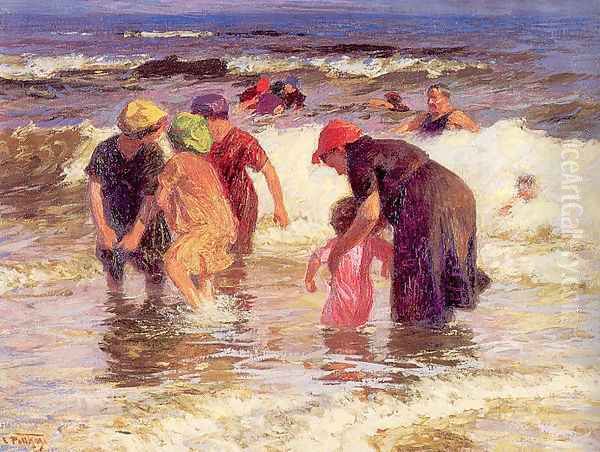
Throughout his career, Edward Potthast achieved considerable recognition within the American art establishment. He was an active participant in the art world, joining several prestigious organizations and exhibiting his work regularly, garnering awards and accolades that solidified his professional standing. His involvement in these groups facilitated connections with fellow artists and provided platforms for showcasing his evolving style.
A significant milestone was his election to the National Academy of Design, a leading institution in American art. He was elected an Associate Member (ANA) in 1899 and achieved full Academician status (NA) in 1906. This recognition by his peers at the Academy was a major honor, signifying his acceptance into the upper echelons of the profession. He frequently exhibited at the Academy's annual exhibitions.
Potthast was also affiliated with other important organizations. He was a member of the Society of American Artists (which later merged with the National Academy), the American Watercolor Society, and the New York Watercolor Club, reflecting his proficiency in both oil and water-based media. His membership in the Salmagundi Club, a prominent New York City art club, further integrated him into the city's artistic community. Additionally, he maintained ties to his hometown through the Cincinnati Art Club. His contributions were further acknowledged later in his life when, in 1924, he was reportedly selected as a member of the National Arts Council.
His work was consistently selected for major national and international exhibitions, where he often received awards. For instance, he won the National Academy's Thomas B. Clarke Prize in 1900 for the best American figure composition and later the Hudnut Prize from the American Watercolor Society. This consistent recognition through memberships, exhibitions, and awards underscores his respected position among American artists of his time.
Connections and Contemporaries in the Art World
Edward Potthast's career unfolded during a dynamic period in American art, and he interacted with, or worked alongside, numerous other significant artists. His training and professional life placed him within overlapping circles of influence and collegiality. His Cincinnati roots connected him to artists like Frank Duveneck, a highly influential painter and teacher associated with the Munich School, whose path Potthast partially followed in his European studies. John Henry Twachtman, another major American Impressionist, also hailed from Cincinnati, though their styles diverged.

In Europe, particularly Munich and Paris, he would have been aware of, or studied alongside, many international artists under teachers like Carl Marr and Fernand Cormon. His exposure to French Impressionism brought him into the orbit of the style's major proponents, even if direct personal contact with figures like Claude Monet or Pierre-Auguste Renoir is not documented; their work was certainly known and influential.
Upon settling in New York and embracing Impressionism, Potthast became part of the broader movement of American Impressionism. He exhibited alongside leading figures such as Childe Hassam, known for his flag paintings and coastal scenes; William Merritt Chase, an influential teacher and painter adept in various styles including Impressionism; J. Alden Weir, another key member of the American Impressionist group "The Ten"; and Willard Metcalf, celebrated for his New England landscapes.
His focus on coastal subjects also aligns him with artists like Charles H. Woodbury, a fellow painter known for his dynamic marine scenes, particularly along the New England coast, where Potthast also painted. The Boston School painters, including Frank Weston Benson and Edmund C. Tarbell, also explored Impressionist techniques, often depicting figures in sunlit interiors or outdoor settings, sharing some thematic ground with Potthast's work. Other contemporaries exploring Impressionism included Robert Reid, known for his decorative figure paintings. While perhaps less directly connected stylistically, he would have also been aware of figures like Robert Henri, a leader of the Ashcan School, who emerged slightly later but shared some exhibition venues. Potthast's participation in major exhibitions and art clubs ensured he was part of the ongoing dialogue and development within American art.
Analysis of Representative Works
Several paintings exemplify Edward Potthast's characteristic style and subject matter. On the Beach, Coney Island (various versions exist) perfectly captures his signature theme. These works typically show crowds of beachgoers, often with children prominently featured, enjoying the sun and surf. The palette is bright, dominated by the blues of the water and sky, the yellows and whites of the sand, and punctuated by the vibrant colors of bathing costumes and umbrellas. The brushwork is loose and energetic, conveying the movement of the waves and the figures, and the dazzling effect of sunlight.

A Holiday or similar titles often depict families or groups enjoying leisure time, perhaps picnicking in a park or relaxing by the sea. These paintings emphasize the cheerful atmosphere and the play of light through foliage or across open spaces. Potthast's skill in rendering dappled sunlight with patches of bright color is particularly evident in his park scenes, often set in Central Park. The figures are rendered with affection, capturing moments of quiet enjoyment or lively interaction.
The Water's Fine (c. 1900-1905), which achieved a high auction price in 2007, is another quintessential beach scene, likely depicting children wading or playing at the water's edge on Long Island. Its title encapsulates the inviting, carefree spirit of his work. The painting showcases his mature Impressionist technique, with sparkling light effects on the water and lively rendering of the figures. The high value it commanded reflects the strong market appreciation for Potthast's most characteristic works.
His paintings from the American West, such as In the Grand Canyon, demonstrate his ability to adapt his style to a different kind of landscape. While still employing an Impressionist approach to light and color, these works convey a sense of grandeur and awe appropriate to the subject. The vast scale is suggested through atmospheric perspective and the dramatic play of light and shadow on the immense rock formations.
Works potentially titled Wading or Beach Scene further reinforce his focus on the simple pleasures of the seaside. A painting described as The Sixteenth and the Cliff (possibly a reference to a location like Ogunquit, Maine, known for its cliffs) might represent his occasional foray into more dramatic coastal views, perhaps depicting waves crashing against rocks, possibly even under moonlight, showcasing a different mood while likely still employing his characteristic brushwork. Regardless of the specific title or location, Potthast's most representative works consistently celebrate light, color, and the joyful moments of American life.
Later Life and Enduring Legacy
Edward Potthast continued to paint actively throughout the later years of his life, remaining dedicated to his preferred subjects of sunlit beaches, parks, and occasional landscapes. He maintained his studio in New York City and continued to exhibit his work, enjoying a solid reputation as one of America's foremost Impressionist painters. By all accounts, he was a relatively private and introverted individual, allowing his cheerful and optimistic canvases to speak for him.
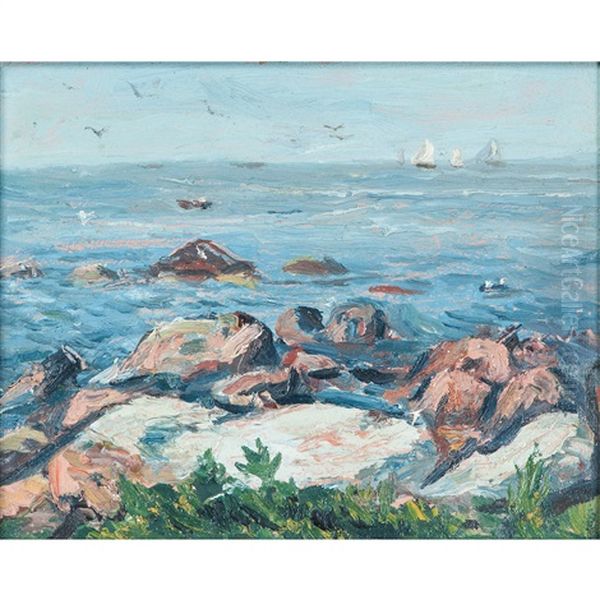
His life came to an end on March 9, 1927, when he died suddenly of a heart attack in his New York studio at the age of 69. His death marked the passing of a significant figure from the generation that established Impressionism as a major force in American art. He left behind a substantial body of work that continues to be admired for its technical skill, vibrant beauty, and evocative portrayal of an era.
In the decades following his death, Potthast's reputation has remained strong, particularly for his beach scenes. His work is held in the permanent collections of major American museums, including the Metropolitan Museum of Art in New York, the Art Institute of Chicago, the Brooklyn Museum, the Cincinnati Art Museum, and many others. This institutional recognition confirms his importance in the narrative of American art history.
Furthermore, his paintings have become highly sought after by private collectors, with prices for his major works increasing significantly over time, especially since the late 20th century revival of interest in American Impressionism. His enduring appeal lies in the universal charm of his subjects – the joy of summer, the beauty of nature, the innocence of childhood – combined with his masterful handling of light and color. He successfully captured a specific, optimistic facet of the American experience at the turn of the century, leaving a legacy of sunshine and cheerful vitality.
Conclusion
Edward Henry Potthast carved a distinct and beloved niche within American Impressionism. From his early days as a lithographer in Cincinnati to his mature career as a celebrated painter in New York, his artistic journey was one of continuous development and refinement. Deeply influenced by his European studies yet firmly grounded in American subjects, he translated the techniques of Impressionism into a personal style characterized by radiant light, vibrant color, and joyful themes. His depictions of bustling beaches and serene parks offer more than just picturesque views; they are luminous records of American leisure culture at a time of optimistic expansion. Through his dedication to capturing moments of simple happiness under the sun, Potthast created an enduring body of work that continues to delight viewers and secure his place as a master of American Impressionist painting.